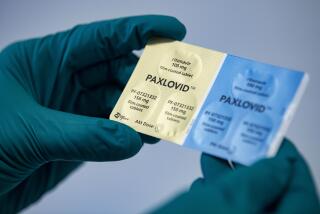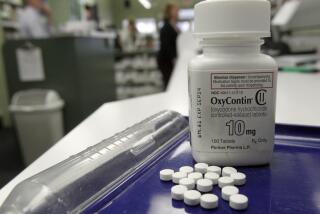Pain Often Mistreated, U.S. Study Finds
- Share via
WASHINGTON — The treatment of hospital patients for acute temporary pain and chronic pain from terminal illness is often “inadequate and insufficient” because of misplaced concern about possible addiction or side effects, while outpatients suffering from other kinds of chronic pain are often overmedicated to the point of addiction, a federal advisory panel concluded Wednesday.
“With acute pain, it doesn’t even make a difference, even if we use heroin, since we generally treat no more than five or six days,” said Dr. Ronald J. Dougherty, a member of the panel of health care professionials convened by the National Institutes of Health. “There is simply no way you’re going to get a patient addicted.”
Inadequate Drug Doses
Nevertheless, the panel said, surveys of hospital patients with acute pain have found that many continue to have moderate or severe pain because they have been given drug dosages “that have been too low or given at too long an interval between doses.”
Dougherty, administrative service chief of the Benjamin Rush Center in Syracuse, N.Y., said such patients should “raise hell” and say: “I want adequate treatment for my pain--now.”
However, patients who are not hospitalized but experience chronic pain--such as migraine headaches or lower back pain--are often subjected to increasing dosages of narcotics “to the point at which significant side effects appear,” the committee said.
“You feel you need to do something for your patients, and this increasing pressure to provide help can lead to misapplication of drugs,” said Dr. Donald S. Kornfeld, a member of the panel and professor of clinical psychiatry at Columbia University College of Physicians and Surgeons.
Non-Drug Methods
The group’s report suggested that sufferers of chronic pain of “non-malignant causes” explore non-drug methods to relieve pain. Among these methods are acupuncture, biofeedback, transcutaneous electrical nerve stimulation, hypnosis, physical therapy and behavioral approaches, such as “coping strategies, desensitization . . . and relaxation.”
The panel, calling pain “an important and complex phenomenon,” said that, despite recent scientific advances in the understanding and treatment of pain, there is no “magic bullet” that will alleviate it.
“Contemporary science and clinical practice cannot assure the full relief of all pain,” the report said. “The data indicate that there remains a proportion of patients whose pain presents difficult, and so far unsolved, problems for successful management.”
Panel members refused to speculate on how many Americans are afflicted with acute or chronic pain, saying there was no reliable information available. They called for additional studies to determine the magnitude of the problem.
But Dr. Emanuel M. Papper, professor of anesthesiology at the University of Miami School of Medicine, estimated that about one-third of the 27 million people who undergo surgery every year will suffer acute postoperative pain and that “40% to 60% of them will be inadequately controlled.”
Personal Attitudes
The panel said that reasons for undertreatment of acute pain include incorrect diagnosis, insufficient knowledge about the drugs, personal attitudes by physicians and other health care professionals about narcotics and “concern about the problems of addiction and respiratory depression that is greater than the actual risk.”
The panel said concern about “the development of tolerance” is the reason terminally ill patients often are undertreated.
“Data indicate that, when dosage requirement increases, the reason is generally disease progression and not increased tolerance,” the panel said. “Physical dependence does occur but is not of clinical significance in advanced disease.”
More to Read
Sign up for Essential California
The most important California stories and recommendations in your inbox every morning.
You may occasionally receive promotional content from the Los Angeles Times.













